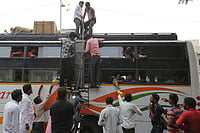The global hyperspectral imaging in the agriculture market is expected to reach $56.88 million by 2026, with a CAGR of 11.93% during the forecast period 2021-2026, according to a recent study.
The study, titled “Global Hyperspectral Imaging in Agriculture Market: Focus on Product, Application, and Country Analysis - Analysis and Forecast, 2020-2026”, says that the growth rate in the market is because of the increased emphasis on precision farming around the world.
The report asserts that due to the increasing global food demand, growers must adopt better ways for growing to maximize their yield increase production.
The technology provides a wide range of solutions for the agricultural industry such as crop stress detection, pathogen detection, and monitoring. With improved technological advancements and better adoption of the technology, hyperspectral imaging will help drive the precision farming market globally.
In India, a digital agriculture mission has been initiated for 2021-2025 by the government for projects based on new technologies like artificial intelligence, block chain, remote sensing and GIS technology, use of drones and robots etc.
Modernisation of the agriculture sector will continue by infusing new technologies so that farmers can increase their income, according to Agriculture Minister Narendra Singh Tomar. His ministry recently signed an MOU for pilot projects with CISCO, Ninjacart, Jio Platforms Limited, ITC Limited and NCDEX e-Markets Limited (NeML).
Based on these pilot projects, farmers will be able to take informed decisions on what crop to grow, what variety of seed to use and what best practises to adopt to maximise the yield. The agriculture supply chain players can plan their procurement and logistics on precise and timely information. Farmers can take informed decisions about whether to sell or store their produce and when and where and what price to sell.
Any attempt to transform agriculture sector needs to imbibe an ecosystem thinking and a digital ecosystem. The agriculture value chain extends from crop selection to crop management and the market; it involves public and private players in agricultural inputs and services and logistics.
Establishing a digital ecosystem of agriculture needs to take a long-term view of aspects like interoperability, data governance, data quality, data standards, security and privacy, besides promoting innovation.
A significant requirement is adoption of a decentralized, federated architecture that assures autonomy to the service providers and all other actors and ensures interoperability at the same time.
Recognising the importance of digitisation in agriculture the department is creating a federated farmers database and building different services around this database so as to build Digital Ecosystems of Agriculture.
Federated farmers’ database will be linked by the land records of farmers from across the country and unique Farmer ID will be created. So far, the database is ready with details of around 5.5 crore farmers.


























